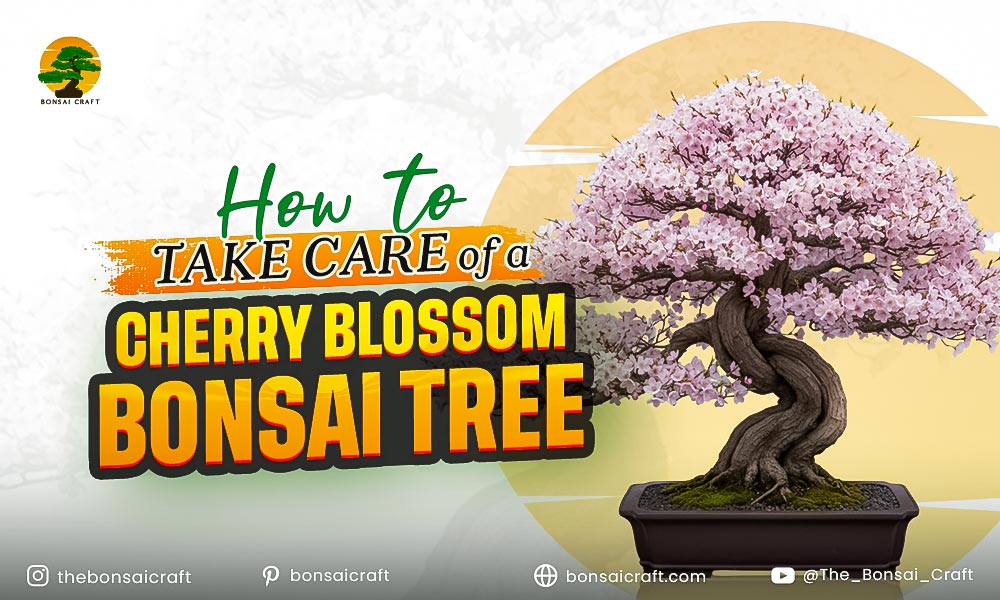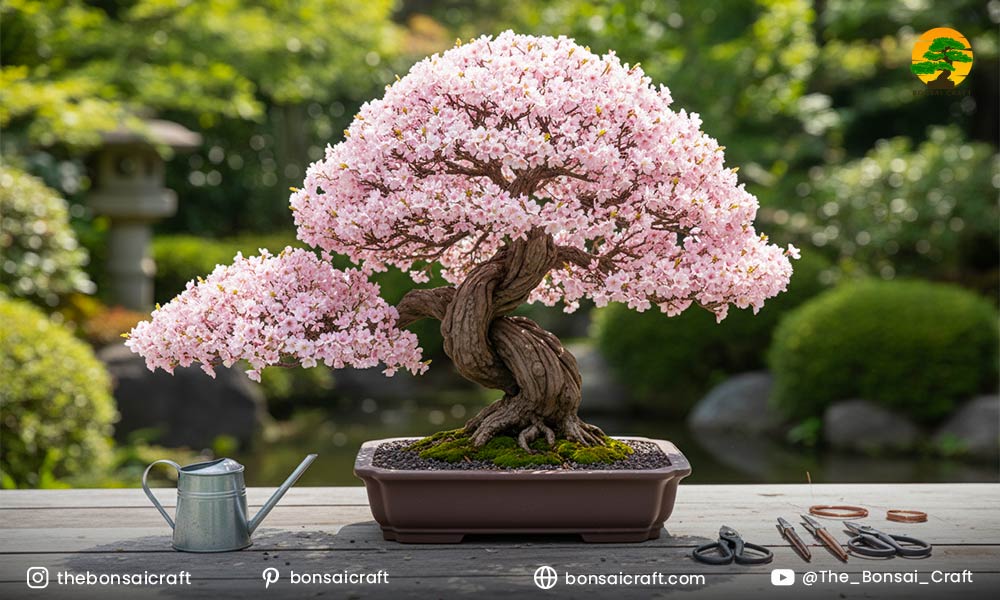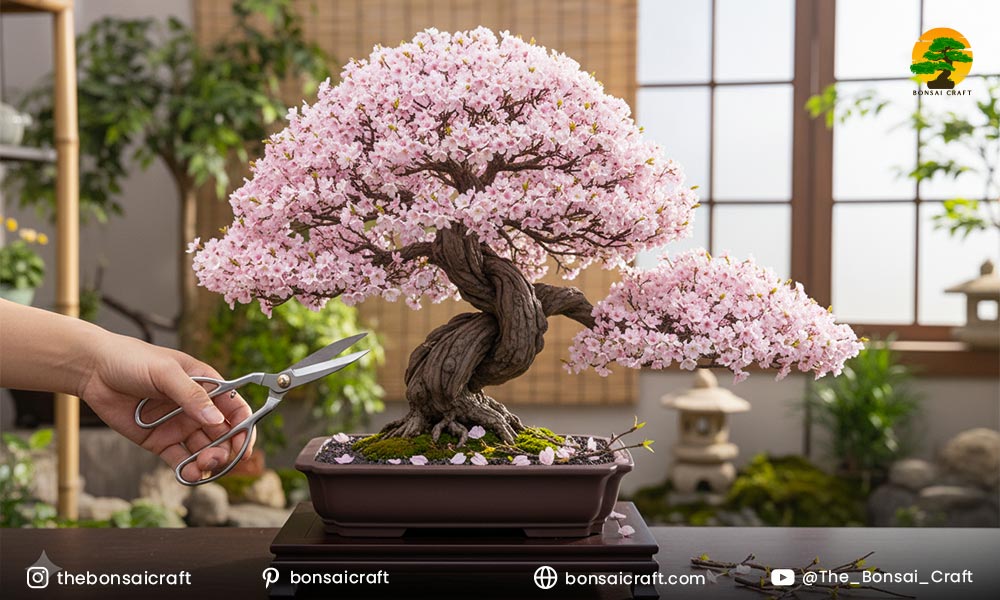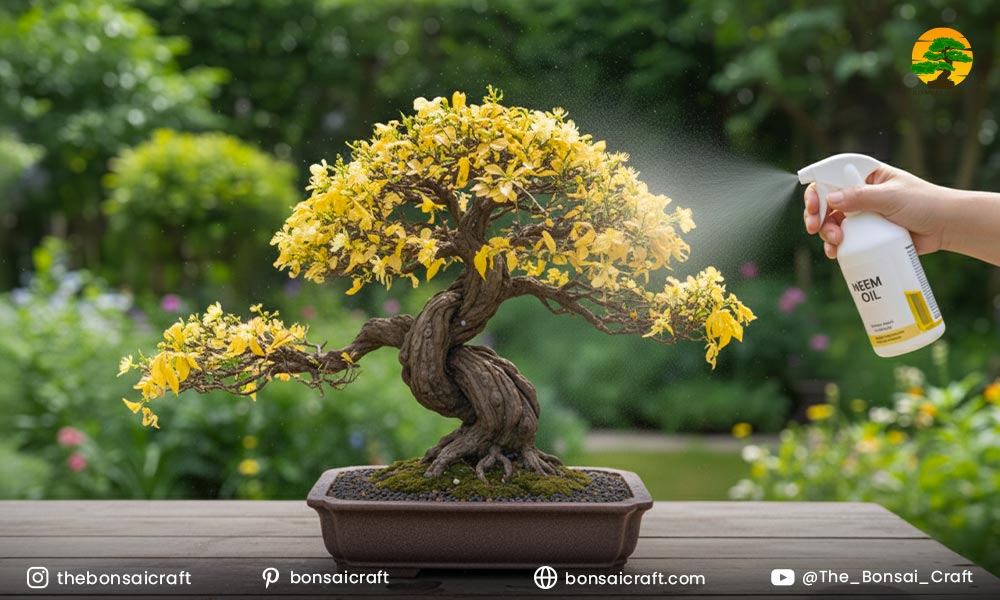
Cherry blossoms are admired worldwide for their fleeting beauty, especially during springtime when they cover landscapes in delicate pink and white blooms. Imagine capturing this elegance in a small pot – that’s the magic of a cherry blossom bonsai tree. From Japan’s iconic bonsai cherry blossom to modern indoor displays, caring for these miniature trees requires patience, technique, and dedication.
In this complete guide, you’ll learn everything about cherry blossom bonsai care, from watering and pruning to styling, propagation, and troubleshooting. Whether you are just starting out or already have experience with bonsai fruit trees, these tips will help you keep your bonsai cherry blossom tree thriving for years.
Understanding the Cherry Blossom Bonsai Tree
The cherry blossom bonsai (Prunus serrulata) originates from Japan, where cherry blossoms symbolize renewal and the fleeting nature of life. The trees are popular for their seasonal flowers, fine branching, and the cultural significance of “Hanami” (flower viewing).
Bonsai enthusiasts love them because:
- They produce real flowers in miniature form.
- They can be styled into many bonsai shapes.
- They embody Japanese bonsai tradition.
Popular varieties include:
- Japanese cherry blossom bonsai (Sakura)
- Weeping cherry blossom bonsai (known for cascading branches)
- Yoshino cherry bonsai (classic white-pink flowers)
- Kwanzan cherry bonsai (dense double blossoms)
How to Grow a Cherry Blossom Bonsai from Seed
To grow a cherry blossom bonsai from seed, stratify seeds in the refrigerator for 2–3 months, then plant in well-draining bonsai soil. Keep moist, warm, and in partial sunlight until seedlings emerge. Growth into a bonsai specimen takes patience and years of training.
Growing from seed is rewarding but requires time:
- Collect or buy seeds – Purchase cherry blossom bonsai seeds from a reputable source.
- Cold stratification – Mimic winter dormancy by chilling seeds at 35–40°F (1–4°C) for 2–3 months.
- Planting – Use a mix of akadama, pumice, and lava rock for aeration.
- Germination – Seeds sprout in 2–4 weeks under the right conditions.
- Nurturing seedlings – Water regularly and provide indirect light.
- Training into bonsai – After 2–3 years, begin pruning and wiring.
Growing from seed takes 5–10 years to achieve a mature mini bonsai tree, so beginners often prefer starting with a nursery sapling.
How to Make a Cherry Blossom Bonsai
To make a bonsai cherry blossom tree, start with a young sapling, prune roots and branches for shape, and plant in a shallow bonsai pot with proper soil. Regular pruning, wiring, and repotting help create a miniature yet balanced tree.
Steps to create your own bonsai:
- Choose material – Use nursery stock or saplings of Japanese cherry blossom.
- Prune initial shape – Remove extra branches and shorten roots.
- Pot selection – Select a shallow ceramic pot with drainage holes.
- Soil mix – A blend of akadama, pumice, and organic matter works best.
- Wiring – Train branches into your desired style.
- Repot as needed – Refresh soil every 2–3 years.

How to Take Care of a Cherry Blossom Bonsai Tree
To care for a cherry blossom bonsai, place it in full sun, water when the soil’s top layer is dry, prune regularly, and repot every 2–3 years. Fertilize during the growing season and protect from frost in winter.
Key care tips:
Light & Placement
- Needs 6+ hours of sunlight daily.
- Outdoors is best; if indoors, use strong grow lights.
- Protect from scorching summer sun and harsh winter frost.
Watering
- Check daily, and water when the top one inch of the soil dries.
- Use a watering can with a fine spout for gentle soaking.
- Do not waterlog the soil, or root rot becomes a possibility.
Fertilization
- Use balanced bonsai fertilizer (NPK 10:10:10) in spring and summer.
- Switch to low-nitrogen fertilizer in late summer for better blooms.
Soil
- Best soil: akadama + pumice + lava rock (well-draining).
- Avoid dense, water-retentive soil.
Pruning
- Maintenance pruning – Pinch back new shoots during the growing season.
- Structural pruning – Do major cuts in early spring before buds open.
Wiring
- Wire branches during dormancy.
- Remove the wire within 3–4 months to avoid scarring.

When to Prune a Cherry Blossom Bonsai
The best time to prune a cherry blossom bonsai is in early spring before new growth, or late fall after leaves drop. Avoid heavy pruning in summer as it stresses the tree.
Pruning tips:
- Focus on removing inward-growing and crossing branches.
- Maintain balance between flowers and structure.
- Regularly pinch new shoots to keep a compact form.
When to Repot a Cherry Blossom Bonsai
Repot a cherry blossom bonsai tree every 2–3 years in early spring before flowering. Trim roots, refresh soil, and ensure good drainage to maintain health.
Repotting guide:
- Gently remove the tree from the pot.
- Trim 20–30% of roots.
- Replant in fresh bonsai soil.
- Water thoroughly and keep in semi-shade for a week.
Styling a Bonsai Cherry Blossom Tree
Boxwood bonsai are styled in multiple ways – and so can cherry blossoms. Popular styles include:
- Formal upright (Chokkan) – Classic straight trunk.
- Informal upright (Moyogi) – Gentle, natural curves.
- Weeping cherry blossom bonsai – Cascading branches with flowers.
- Multi-trunk bonsai – Several trunks in one pot for a forest effect.
- Miniature bonsai tree – Compact styling under 10 inches tall.
Styling combines pruning, wiring, and patience.

Common Problems with Cherry Blossom Bonsai Care
- Yellowing leaves → Overwatering or poor drainage.
- No flowers → Insufficient sunlight or wrong fertilizer.
- Leaf spots or fungus → Caused by humidity and poor airflow.
- Pests (aphids, spider mites, caterpillars) → Treat with neem oil or insecticidal soap.
Regular monitoring prevents long-term damage.
Expert Tips for Bonsai Cherry Blossom Trees
- Don’t let the soil dry out completely; cherry blossoms dislike drought.
- Protect roots from freezing in winter with mulch or frost cloth.
- Rotate your bonsai for even sunlight exposure.
- Patience is key: blooms often take several years of proper care.
Conclusion
The cherry blossom bonsai tree combines Japanese tradition, natural beauty, and horticultural art in one miniature form. With proper watering, pruning, and styling, even beginners can enjoy the charm of bonsai cherry blossoms.
As an enthusiast, my advice is to start with a nursery-grown sapling for quicker results, then progress to growing from seeds once you master the basics. Remember, bonsai is not just about the tree – it’s about the journey of nurturing life in miniature.
FAQs About Cherry Blossom Bonsai Trees
Can you grow a cherry blossom bonsai indoors?
You can grow an indoor cherry blossom bonsai, but it needs bright grow lights, elevated humidity conditions, and frequent watering. Generally, outdoor placement is healthier.
How long does it take to grow a cherry blossom bonsai from seed?
It takes 5-10 years to grow a cherry blossom bonsai from seed to a mature, flowering bonsai. Patience is key!
What type of soil is best for cherry blossom bonsai?
For cherry blossom bonsai, the best soil is a well-draining akadama, pumice, and lava rock mix. It will provide proper aeration as well as moisture retention.
Are cherry blossom bonsai hard to care for?
Cherry blossom bonsai require moderate skill to maintain. With just the right balance of sun, water, and pruning, a cherry bonsai can thrive, but you must be attentive.
How to plant cherry blossom bonsai seeds?
Cherry blossom bonsai seed stratification takes place for 2-3 months. After this, the seed can be placed in a bonsai soil and moisture is required in warm conditions until the soil sprouts. Germination may take several weeks.
